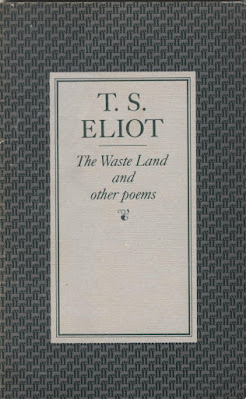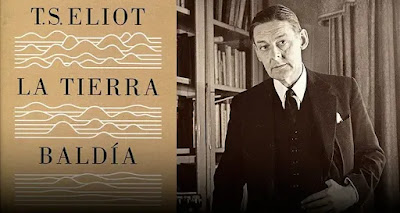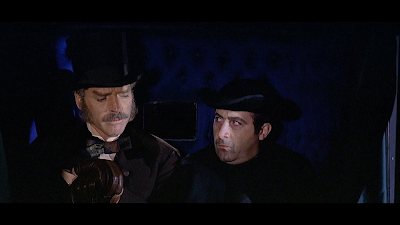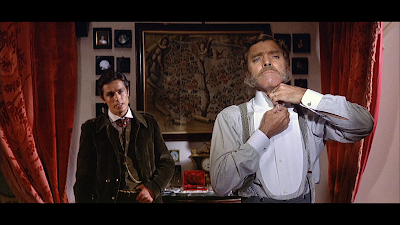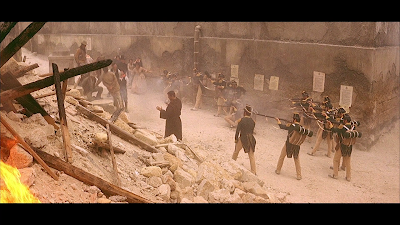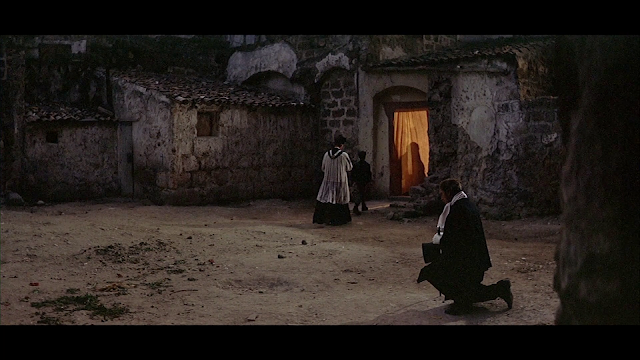GIUSEPPE TOMASI DI LAMPEDUSA,
IL GATTOPARDO: HOW TO CHANGE EVERYTHING, SO THAT
EVERYTHING (ALMOST) REMAINS AS IT WAS.
A
painful confession, to begin with: I have seen the Luchino Visconti
(*1906-†1976) film
version (1963)
on many occasions), first time end of the 1960s, but I confronted the
novel (1958, (Il Gattopardo, The Leopard) as such only last
year, as chance allowed a translation into German to fall on my
hands. The original Italian version was bought shortly afterwards

A
possible explanation for this décalage may have
been the desire to read it in Italian, as I suspected that only the
Italian text would suffice to let the images and sounds reverberate
again, in the primaeval matrix, to confront, once more, that most
precious of questions: Can a magisterial film subsume all the
essence of such a novel? Provisional answer: A substantial part of
it, yes, but some layers remain hidden in the texture of the novel. A
not to be underestimated caveat: The film stops at the end of
“Parte VI”, thus not incorporating “Parte VII” and “Parte
VIII”, which take the action well beyond the 1860s, into the early
20th century. A tiny proportion of “Parte V” is
incorporated as a dialogue of the Padre Pirrone with peasants
in “Parte II”.
Both
decisions are very clever, underlying the necessarily different ways
of “handling” a novel and its “film version”. By limiting the
action to the interval between 1860 and 1862, the “essence” of
the novel is maintained, yet at the same time, the “saga” is kept
compact and tense, as there are no “post-faces” stretching the
narration over half-a-century which may dilute the core of the
handling and the descriptions. A fuller integration of “Parte V”,
which takes us with Padre Pirrone into his place of birth, would have
been an unnecessary deviation from the “main stream”, the
narration of the key events which underpinned the backbone of the
text.
Thus
this blog’s entry is an invitation, in particular to those who have
seen the film, to read the novel, if possible in Italian. It would
help to enjoy the cinematographic version
even more, and to understand why there are
descriptions and subdued allusions that cannot be transported onto
the cinema-screen.
Visconti’s
film (1963) is not only his capolavoro, it is one of the
capolavori in the whole history of Italian cinema, and one
of the greatest films ever made. Such accolades remain almost
uncontested, as Visconti, as well as his camera and photography
director, Giuseppe Rotunno (*1923-†2021)
somehow managed to count on the technical advise of Rembrandt,
Velázquez, Dürer, Caravaggio, Goya, Manet, Renoir et cetera…
Try taking out almost any frame of the film, “frame” it as such,
and hang it on the walls of any beaux arts museum: Nothing
extraneous has been incorporated. The whole panorama is even
enhanced.
A German edition
----------------------------------------------------------------------------------------------------------------------
Yet
you cannot achieve such a pinnacle in cinema, unless the original
source bathes itself in very high-carat. Indeed, the novel Il
Gattopardo is one of the most fascinating,
emblematic European novels of the 20th
century. And perhaps also the most relevant in generating
ex post, its own political theory regarding “continuity
and change” in society: il gattopardismo.
Giuseppe
Tomasi di Lampedusa (Palermo, 23 dicembre 1896 – Roma, 23
luglio 1957), “11º principe di Lampedusa, 12º duca di Palma,
barone di Montechiaro, barone della Torretta, Grande di Spagna di
prima Classe (titoli acquisiti il 25 giugno 1934 alla morte del
padre)”,
could not see his beloved novel printed, having been refused by two
major Italian publishing houses. It came out after his death,
reaching a very large audience immediately, and it has been
translated into almost every language. He was in no doubt as to the
value of his opus, as transpired in his last letters before his
death. Anyone reading the first pages in Italian would realise, at once, that we have in our hands a work of art into which the
author had invested his soul, his blood, his remembrances, his dreams
and his nightmares, to construct a fantastic, penetrating fresco of
an epoch and of a family (his own, roughly speaking…), poetizing
the landscape of Sicily to the point that we can smell the odours of
the olives and the vineyards. We touch the salted drops of water of
the Mediterranean, transported by the wind onto the arid hills and
mountains of that land which had belonged to the Phoenicians, the
Greeks and the Arabs. The Sicilians being the mixture of all that‒and much more. Let us just visit the “garden for the blind”,
around the palazzo of il
Principe de Salina:
“Era
un giardino per ciechi: la vista costantemente era offesa ma
l’odorato poteva trarre da esso un piacere forte ben che non
delicato. Le rose Paul Neyron le cui piantine aveva egli stesso
acquistato a Parigi erano degenerate: eccitate prima e rinfrollite
dopo dai succhi vigorosi e indolenti della terra siciliana, arse da
lugli apocalittici, si erano mutate in una sorta di cavoli color
carne, osceni, ma che distillavano un denso aroma quasi turpe che
nessun allevatore francese avrebbe osato sperare. Il Principe se ne
pose una sotto il naso e gli sembro di odorare la coscia di una
ballerina dell’Opera (Parigi),
“It
was a garden for the blind: The eyes were constantly offended but the
nose could draw from it a strong pleasure, albeit not a delicate one.
The Paul Neyron roses, whose cuttings he had himself bought in
Paris, had degenerated: Excited first and weakened later by the
vigorous and indolent juices of the Sicilian earth, burned by the
apocalyptic July, they had turned into a sort of flesh-coloured
cabbage, obscene, but distilling a dense, almost indecent aroma that
no French cultivator would have dared hope for. The Prince put one
under his nose: He seemed to smell the thigh of a dancer from the
Opera (Paris).”
None
of the above was transposed onto the screen-it would have been almost
impossible, had someone attempted it.
“Maggio
1860. “Nunc et in hora mortis nostrae. Amen”. La recita
quotidiana del Rosario era finita.” Beginning of the novel and the
film.
“The daily recital of the Rosary was finished.” from left to
right: Padre Pirrone (Romollo Valli), Don Fabrizio
Corbera, Prince of Salina (Burt Lancaster), Concetta Corbera,
eldest daughter of il Principe (Lucilla Morlacchi), Princess
Maria Stella of Salina, Don Fabrizio's wife (Rina
Morelli). Il Palazzo Salina is in reality the “Villa
Boscogrande” in Palermo.
--------------------------------------------------------------------------------------------------------------------
This
is not only a “historical novel”, it is a love-song to Sicily,
with all its tremendous contradictions. Not to be forgotten: This is
also a “Catholic novel”...
Most
of the action takes place at the time of the Italian Risorgimento, centered on the commotion and upheavals caused by the landing of
Giuseppe Garibaldi and his “proletarian” (but not only) army,
known as The Thousand, I Mille di Garibaldi, on the
Sicilian coast, May 1860. Soon they will overthrow the Kingdom of
the Two Sicilies, run by the Bourbons, and integrate the island
to a new, unified Italian Kingdom under Victor Emmanuel (Vittorio
Emanuele II, *1820-†1878,
as from 1861 “King of Italy”, “Padre della Patria”)
The
mirror which reflects and reverberates all those changes is the
Salina family, headed by il Principe Fabrizio, a tall, robust
patriarch who imposes a strict Roman Catholic conduct and ritual upon
its family, and devotes himself, together with Padre Pirrone,
to science and astronomical observations, Don Calogero Sedàra
which seemed to find some positive echo in Paris. He is actually of
half German descent, half Sicilian.
“Ma
nel sangue di lui fermentavano altre essenze germaniche ben più
incomode per quell’aristocratico siciliano nell’anno 1860, di
quanto potessero essere attraenti la pelle bianchissima ed di capelli
biondi nell’ambiente di olivastri ed di corvini: un temperamento
autoritario, una certa rigidità morale, una propensione alle idee
astratte che nell’habitat molliccio della società palermitana si
erano mutati in prepotenza capricciosa, perpetui scrupoli morali e
disprezzo per i suoi parenti e amici che gli sembrava andassero alla
deriva nel lento fiume pragmatistico siciliano.”
"But
other Germanic essences fermented in his blood, much more
uncomfortable for that Sicilian aristocrat in the year 1860, however
attractive the very white skin and blond hair may appear in the
environment of olive trees and ravens: An authoritarian temperament,
a certain moral rigidity, a propensity for abstract ideas that in the
sloppy habitat of Palermo’s society had turned into capricious
arrogance, perpetual moral scruples and contempt for his relatives
and friends who seemed to him to swim adrift in the slow Sicilian
river of pragmatism.”
No,
this is not “a Caravaggio”, albeit it seems, but a portrait of il
Principe de Salina and Padre Pirrone, travelling to
Palermo. “Che bel paese sarebbe questo, Eccellenza, se…”,
“”What a nice country would be this, if…”, says Pirrone to il
Principe, who interrupts him, “Se non vi fossero tanti
Gesuiti!”, “If there weren't too many Jesuits!”
-------------------------------------------------------------------------------------------------------------------------
His
“alter ego” is composed of camouflaged sensuality and eroticism,
which allows him to enjoy half-clandestine liaisons, be either in
Paris or in the suburbs of Palermo.
“I
ruderi libertini!”, “what a wrack of libertines!”, Tancredi
(Alain Delon), to his uncle after a concealed naughty libertine night
in Palermo.
--------------------------------------------------------------------------------------------------------------------------
Instead
of taking refuge by the “British”, as his brother does on
learning of the advance of Garibaldi and his soldiers, il Principe
de Salina soon adopts a much more pragmatic, conciliatory
attitude:
“Molte
cose sarebbero avvenute, ma tutto sarebbe stato una commedia, una
rumorosa, romantica commedia con qualche macchia di sangue sulla
veste buffonesca. Questo era il paese degli accomodamenti, non c’era
la furia francese; anche un Francia d'altronde, se si eccettua il
Giugno del Quarantotto, quando mai era successo qualcosa di serio?”
“A
lot of things would happen, but it would all be a comedy, a noisy,
romantic comedy with a few bloodstains on the buffoonish robe. This
was the land of “arrangements”, there was no French fury; even in
France, on the other hand, with the exception of June 1848, when had
anything serious ever happened?”
“Se
non ci siamo anche noi, quelli ti combinano la reppublica. Se
vogliamo que tutto rimanga comme è, bisogna che tutto cambi. Mi sono
spiagato?“
Tancredi giving a formidable political lesson to his uncle, il
Principe de Salina. “….Unless we take the lead again, those
guys are going to concoct a republic upon us. If we want everything
to remain as it was, everything needs to be changed. Have I made
myself clear?”
-----------------------------------------------------------------------------------------------------------------------
That
reflects also his way of handling employees and tenants, which
combined distance, but also affection‒and
tolerance. Be either by “ignoring” the cases of lemons which had
been stolen by one of his devoted administrators, or “forgetting”
to ask for the annual delivery of tributes in species from his
tenants, specially when he visits Donnafugata, that
refuge which allows him to escape from gossips and the skirmishes in
Palermo, going there “to rusticate themselves”.
Padre
Pirrone attempting to digest, without too much stomach-pain, the
intimate confessions of il Principe de Salina, who has just
been remonstrated because of his naughty escapade to Palermo. “Seven
children I’ve had with her! (his wife) Seven! And do
you know what, Padre? I have never even seen her navel…”
Dialogue added by the screenwriters.
----------------------------------------------------------------------------------------------------------------------------
Entry
of the family of il Principe de Salina into the Cathedral
(Chiesa Madre) in Donnafugata, to assist at the
traditional Te Deum offered to the family on its arrival at
the town. Don Francisco "Ciccio" Tumeo (Serge
Reggiani), organist and an old friend of il Principe,
plays the melody of Violeta’s begging for love, Amami, Alfredo,
in La Traviata of Giuseppe Verdi (*1813-†1901).
The melody is also contained in the overture of the opera.
----------------------------------------------------------------------------------------------------------------------------
No,
this is not “a Rembrandt”. This is a scene in the cathedral, at
the beginning of the Te Deum. On a wall outside one can read
the inscription: VIVA GARIBALDO. It should have been “Garibaldi”,
though in the novel it is written “Viva Garibbaldi”. ---------------------------------------------------------------------------------------------------------------------------
To
be noticed: The facial expression of Don Calogero Sedàra, mayor
of Donnafugata (Paolo
Stoppa), (left),
who gazes at the Salina family, convinced that the moment has come,
to seal an “alliance” between the slowly crumbling aristocracy
and the ambitious new “bourgeoisie”, that is, an “alliance”
between “prestige” and “money”. To be accomplished, as God
disposes, only through “marriage”. --------------------------------------------------------------------------------------------------------------------------
A
combination of Rembrand, Velázquez, and Dürer. The Salina family
at its privileged position in the Cathedral, still bearing tonnes of
dust accumulated during the journey.
------------------------------------------------------------------------------------------------------------------------
The
long expedition (“Il viaggio era durato tre giorni ed era stato
orrendo”)
in carriages of the family to Donafugatta, through the arid
landscapes, where at times trees were unknown creatures, was perhaps
one way of torturing themselves, or in the case of il Principe,
that of paying for his sins. “Mademoiselle Dombreuil, “la
governante francesa”, who had spent some years in Algeria could
not contain herself: “Mon Dieu, mon Dieu, c’est pire qu’en
Afrique!”.
There he would be received officially, with all the pomp the town
could afford, by Don Calogero Sedàra, major
of Donafugatta, a
„self-made man“ rapidly accumulating wealth, fierce advocate of
the “revolutionaries”, jet admirer of the Salinas, of awkward and
inelegant manners, yet shrew and pragmatic. Her daughter Angelica
will soon captivate Tancredi, the nephew of il Principe de
Salina.

Angelica
(Claudia Cardinale), only daughter of Don Calogero Sedàra, mayor
of Donnafugatta, makes her entry into the
sumptuous rooms of the Salina’s palazzo in Donnafugata.
A hint of Pierre-Auguste Renoir but also
Édouard Manet.
--------------------------------------------------------------------------------------------------------------------------
“...ed
entrò Angelica. La prima impressione fu di abbagliata sorpresa. I
Salina rimasero col fiato in gola. Tancredi senti addirittura come
gli pulsassero le vene delle tempie. Sotto l’impeto della sua
bellezza gli uomini rimasero incapaci di notare. (…) Sotto la massa
dei capelli color di notte avvolti in soavi ondulazioni, gli occhi
verdi albeggiavano, immoti come quelli delle statue e, com’essi, un
po’ crudeli. (…) recava nella persona la pacatezza,
l'invincibilità della donna di sicura bellezza.”
“…
And Angelica entered. The first impression was one of dazzled
surprise. The Salinas stood there with breath taken away. Tancredi
even felt how the veins in his temples were throbbing. Under the
impetus of his beauty, men were unable to notice. (...) Under the
mass of night-coloured hair wrapped in gentle undulations, her green
eyes gleamed motionless, like those of the statues and, like them, a
little cruel. (…) She walked slowly (…) letting emanate from of
her the calmness, the invincibility of a woman sure
of her beauty. "
Reaction
of il Principe de Salina…
------------------------------------------------------------------------------------------------------------------
Reactions
of Tancredi and of Concetta, one of the daughters of il
Principe de Salina, who is supposed to be on her way to become,
before long, Tancredi’s bride.
------------------------------------------------------------------------------------------------------------------------
The
key dialogue between il Principe and Don Ciccio, while
hunting early in the morning:
„La
verità, Eccellenza, è don Calogero è molto ricco e molto influente
anche; che è avaro (cuando la figlia era in collegio lui e la moglie
mangiavano in due un uovo fritto) ma che quando occorre sa
spendere.(…) ma un mese fa ha prestato cinquanta onze a Pasquale
Tripi che lo aveva aiutato nel periodo dello sbarco; e senza
interessi, il che è il pio grande miracolo che si sia visto da
quanto Santa Rosalia fece cessare la peste a Palermo. Intelligente
come un diavolo.“
“The
truth, Excellency, is that Don Calogero is very rich and very
influential too; we know that he is a miser (when his daughter was at
school he and his wife used to share a fried egg) but when something
happens he knows how to spend (…) a month ago he loaned fifty
“ounces” to Pasquale Tripi, who had helped him at the time of the
disembarkation; and without interests, which is the biggest miracle
to have been seen around here since Santa Rosalia extinguished
the pest in Palermo. As intelligent as the devil…”
Don
Ciccio, who voted “no” in the plebiscite (albeit no “no
vote” was registered in Donafugatta would consider the “marriage”
between Tancredi and Angelica as “treason, the end of the
Falconeris (family of Tancredi) and even of the Salinas…“
The
battle on the streets of Palermo. Please confront “The execution of
Maximiliam” (1868/69) by Édouard Manet. And also “Los
fusilamientos del 3 de mayo de 1808”, “Execution of the Citizens
of Madrid”, completed by Francisco de Goya in 1814.
---------------------------------------------------------------------------------------------------------------------------
Battle
on the streets of Palermo. Please confront “Los desastres de la
guerra” (The Disasters of War), a series of 82 prints created
between 1810 and 1820 by Francisco de Goya.
----------------------------------------------------------------------------------------------------------------------
The
future husband of Angelica would return with a comrade, wearing the
new uniform of the regular forces of the new Kingdom of Italy, making
haste to distance themselves from the “proletarian
revolutionaries”:
„Ma
insomma, voialtri garibaldini non portate più la camicia rossa?“.
I due si voltarono come se li avesse morsi una vipera. „Ma che
garibaldini e garibaldini, zione! Lo siamo stati, ora basta“ (…)
Con quelli lì non si poteva restare (…) Mamma mia che gentaglia!
Uomini da colpi di mano, buoni a sparacchiare, e basta!“
„But,
after all, you the garibaldini no longer wear the red shirt?”
The two turned around as if a snake had bitten them. “But, uncle,
forget the garibaldini and garibaldini! We had been,
and now it is all over. We could not have possibly remained there
with those guys! Mamma mia, what a mob! Good for ambushes and
looting, and that’s all!”
Sharply
attacked by the Italian Communist Party (to which Visconti felt very
close) when it was first screened, the film was accused of being
“politically conservative”, expressing a “reactionary ideology”
by more or less by the whole spectrum of the Italian left.
Visconti even concocted a different version, adding much more
references to the “class struggle” and the “peasant resistance”
(which were eliminated of the version presented at the Venice
Festival), but even that concession did not seem to placate the
vociferous critics, the insistence being upon “il
anti-storicismo” of the film. That the vision-of-the-world
transpiring out of the novel, and out of its cinematographic
translation, was one of rejecting the possibility of “progress”,
or “real changes” taking place in society. Or at least in Sicily.
Should
that really be the final conclusion to be extracted? Does the
statement “...If we want everything to remain as it was,
everything needs to be changed…” really implies that
“revolutions” are much more “superficial” than what they
appear at first? No one could possibly imagine that Giuseppe Tomasi
di Lampedusa attempted to deny the possibility of change, the
inevitability of at least some “progress” taking place, albeit
perhaps at much slower rhythm.
I
happen to believe that the gattopardismo should not be
interpreted as a cynical approach to history, insisting on the
futility of “vociferous and radical speeches”, and even of
thunderous street battles and brief, or even long, “civil wars”.
It is rather the conviction that there is a constant need to find a
new “equilibrium”, let us call the “Lampedusian
equilibrium”, that there is an innate trend in society to
“re-arrange” the bits and pieces, to find a new way of
“coexistence”. In the concrete case of this Sicilian novel, it
means probably that:
“...the
upper classes agree to behave a “little less conservative”, and
the “revolutionaries” agree to behave much more “less
revolutionary”...
“...e
il giorno del matrimonio consegnerò allo sposo venti sacchetti di
tela con mille “onze” ognuno…”
Don Calogero enhancing the pre-nuptial deal between Tancredi
and Angelica, by “...on the day of the wedding I shall give to the
bridegroom twenty linen sacks, each of them containing 1,000 ounces
of gold…” Padre Pirrone “monitors” the whole
transaction, while “reading” unobtrusively in a corner.
-------------------------------------------------------------------------------------------------------------------------
Angelica
yearning for the long-awaited, just-about repressed first intimate
communion with her fiancé, while playing and exploring the labyrinth
of forgotten and uninhabited rooms and corridors in the Salina’s
palazzo in Donnafugata, which
constitutes in fact “il nucleo segreto centro
d’irradazione delle irrequietudine carnali del palazzo...”,
the secret core, the centre of
the radiations of the carnal anxieties of the palazzo…”
-------------------------------------------------------------------------------------------------------------------------------
And those days, playing like
excited children and caressing the frontier of sensuality, but not
trespassing it, were to constitute the best moment of their lives:
“Quelli
furono I giorni migliori della vita di Tancredi e quella di Angelica
(…) Quando furono divenuti vecchi e inutilmente saggi I loro
pensieri ritornavano a quei giorni con rimpianto insistente: erano I
giorni del desiderio sempre presente, perché sempre vinto, dei
letti, multi, che si erano offerti e che erano stati respinti, dello
stimolo sensuale che appunto perché inibito si era, un attimo,
sublimato in rinunzia, cioè, in vero amore.”
"Those
were the best days of Tancredi's life and that of Angelica (...) When
they became old and uselessly wise, their
thoughts returned to those days with insistent regret: they were the
days of ever-present desire, because always conquered; of beds, many
of them, which
had offered themselves, and which
had been rejected; of the sensual stimulus which, precisely because
it was inhibited, was, for a moment, sublimated into renunciation,
that is, into true love. "
21
pages, between pp. 211-232, in the novel are used to describe the
„ball“ in the palazzo Ponteleone
(in the film the location is the palazzo
Valguarnera-Gangi, in Palermo). That represents
about 10 percent of the pages of the novel which were
“screen-written” in the film. Yet the screen version of that
sequence occupies almost one third of the length of the film.
“The
impossible love”, il Principe de Salina dancing a waltz with
Angelica (at her request…), letting eyes and words communicate that
well-hidden, unspoken desire. Tancredi watches that dancing
exhibition, just about containing jealousy and fear.
-------------------------------------------------------------------------------------------------------------------------
Is
that a disproportionate “zoom-in” of such a tiny proportion of
the text? Not quite, although there is no doubt that Visconti and his
teams decided to widen that evening at the palazzo Ponteleone,
fist of all, in order to apply a sumptuous choreography, and let
glittering attires, whose colours had been meticulously premeditated,
glide before our eyes, as an incessant flow of images, as if the best
tableaux of the best museums have been joint together, and let to
float around, distilling gold and silver:
“the
ball in the palazzo, which runs as a favourite in the competition to
designate the most beautiful film-sequence of all time…”
Visconti
also extends the “ball scene” to let it operate as a magnetic
field, a reverberating human landscape of all the Leitmotiven,
the themes of the whole novel. It is the “presentation in society
(high)” of Angelica, and even of her father, whose clothes have
been selected by his future son-in-law. It is the reunion of il
Principe de Salina with his relatives, and even with his former
lovers. The new military officers turn in, who in the next early
morning are going to execute the “rebel soldiers”, those who did
not want to let the “revolution” fade away. The new Lampedusian
“equilibrium” is consecrated and rejoiced.
The
young ladies kicking around, sitting, or even jumping like pigeons
caught in a whirlwind of desires and excitements, letting their fans
act as wings, the colours of their dresses representing a harmony a
white, orange and gold, almost a reflection of the walls in which
they celebrate the evening.
---------------------------------------------------------------------------------------------------------------------------
It
is the mingling and contrast between “youth” and “old-age”,
the awareness of the brief splendour of gallantry and vanity, and the
inevitability of death.
A
perfect composition of colours: white, then dark-blue, crowned by the
red roses.
---------------------------------------------------------------------------------------------------------------
“...la
carrozza se fermò; si sentiva un gracile scampanellio e da una
svolto comparve un prete recante un calice col Santissimo; dietro un
chierichetti gli reggeva sul capo un un ombrello bianco ricamato in
oro; davanti un altro teneva nella sinistra un grosso cero acceso, e
con la destra agitava, divertendosi molto, un campanellino di
argento. Segno che una di quelle case sbarrate racchiudeva un’agonia,
era il Santo Viatico. Don Fabrizzio scese, s’inginocchio sul
marciapiede, le signore fecero il segno della croce, lo scampanellate
dileguò nei vicoli che precipitavano verso S. Giacomo, la calèche
con i suoi occupanti gravati di un ammonimento salutare s’incamminò
di nuovo verso la meta ormai vicina.”
“...
the carriage stopped; a feeble ringing was heard and a priest
carrying a chalice with the Blessed Sacrament appeared from a corner;
behind him followed an altar boy, who held a white umbrella
embroidered in gold over his head; in front of him another held a
large lighted candle in his left hand, and with his right he waved a
silver bell, very much amusing himself. A sign that one of those
barred houses enclosed an agony, it was the Holy Viaticum (Last
Sacrament). Don Fabrizzio got out, knelt on the pavement,
the ladies made the sign of the cross, the bells disappeared in the
alleys that rushed towards S. Giacomo, the calèche with its
occupants, burdened with a salutary warning, set off again towards
the destination, now quite close."
What
does a man do, even if he were to be a “Leopard”, when he
realizes that youth has gone for ever, that the sensual pleasures have
lost their intoxicating initial splendour, and no longer
constitute the compass of daily life?
He
does as follows:
Final
scene of the film: Il Principe de Salina, having...
kneels down in a modest suburb of Palermo. In the novel this scene
comes before the Salina family arrives at the ball, not after.


